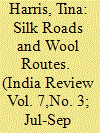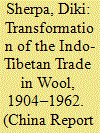| Srl | Item |
| 1 |
ID:
092419


|
|
|
|
|
| Publication |
2009.
|
| Summary/Abstract |
There are only a few Chinese families settled in North Bengal, concentrated in the towns of Siliguri and Kalimpong. The Chinese have on an average been a literate community but few of them continued for post-secondary education. The reasons were that many of them were engaged in business at an early age which was much more lucrative and on the other hand some people were struggling to maintain their establishment. Economic challenges left little time and recourses to concentrate on education. However, since the community has prospered and with time, parents increasingly opt to send their children to school. These days, the occupational needs of the Chinese youth in North Bengal can be divided into two categories, either to migrate abroad or to be a successful businessman. It is perceptible that Chinese in India are conscious with regard to the education of their children. English-medium schools are the preferred institutions and for this the Chinese have adopted another strategy-that of conversion to Christianity. Since Christians have some concessions in the admission process, in Convent schools, many Chinese see conversion as a solely utilitarian issue
|
|
|
|
|
|
|
|
|
|
|
|
|
|
|
|
| 2 |
ID:
178155


|
|
|
|
|
| Summary/Abstract |
Succeeding waves of mobilisation for the separate state of Gorkhaland has left an indelible imprint on the cultural, political and urban landscape of the Darjeeling Hills. Based on empirical research, this paper tries to explore the intricate relationship between ethnicity, place and politics of belonging in the Himalayan town of Kalimpong. It specifically tries to locate the interface between political events and the transformation of the urban landscape by taking into consideration the growth of roadside settlements. While noting the specific contours of these settlements, their culture and their liminal condition, the paper tries to address the issues pertaining to place-making and identity formation in the Himalayan region.
|
|
|
|
|
|
|
|
|
|
|
|
|
|
|
|
| 3 |
ID:
084549


|
|
|
| 4 |
ID:
169957


|
|
|
|
|
| Summary/Abstract |
During the first half of the twentieth century, the wool trade articulated new political and economic relationships between Tibet and the British Raj in India and the world beyond. Kalimpong, the Eastern Himalayan town in North Bengal, flourished on the basis of India’s frontier trade with Tibet for about five decades. By placing the trans-frontier wool trade of colonial India at the centre of analysis, this article seeks to highlight the material history that existed on its landed periphery. An attempt will be made to understand the emergence, pattern and significance of India’s trans-frontier trade with Tibet in the light of major geopolitical changes in this region and the world in the twentieth century. The article will argue that the channelling of trade through the Kalimpong–Lhasa route was driven by multiple colonial interests, as well as commercial considerations. In particular, safeguarding the empire and producing a unified sovereign space in the newly established Himalayan frontier constituted a major concern of the British Raj.
|
|
|
|
|
|
|
|
|
|
|
|
|
|
|
|